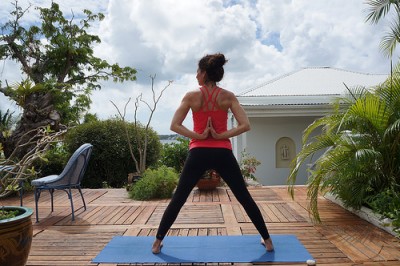
As I’ve been reviewing the chapters in my soon to be released self-published book, “Stretched: Build Your Yoga Business, Grow Your Teaching Techniques,” I hope you can see how the chapters have been sorted in an order such that the business chapters are first and then as we started to get into the teaching chapters, they’ve built on various themes that go beyond basic training. Topics like the preceding chapter, “Managing Challenges in the Classroom,” and now this one, “How to Build a Class Around a Theme” touch on topics that go beyond knowing how to teach the poses and get into the application of the information in different ways. We’re also diving a bit deeper into the techniques used while teaching and as you will see in the subsequent chapters, we’ll get even more specific.
Let me start by saying that using themes for teaching is something that is fun to do after you’re really comfortable teaching a steady, regular sequence. I’ve really believe in the value to both newer teachers and students to using a regular sequence for the first few years of teaching. I know this might sound like a long time but honestly, it takes a few years to really get comfortable managing all the variables that can come up while teaching. It doesn’t mean that you don’t add in or take out a few things but it means that generally, you stick to the same flow. One of the challenges for new teachers attending training is that they are not always taught a particular sequence to use. They are taught poses without a “container” within which to present them. So, once you’ve gone through your training, if you have not been taught a particular order for the poses (in a 60 or 90 minute flow) work with the lead teacher of your program to create one.
As you gain more experience and wish to play with different themes, there are many ways you can approach this. In this chapter, I present different ideas for themes and they’re grouped into different categories: physical themes, themes inspired by challenges we may face, breath, uddiyana bandha, setting a firm foundation and opening the muscles of the chest. There are many other themes you can choose and in fact, many can be anatomical. Because my teaching leans heavily towards the anatomical, both in themes, cuing and sequencing, I usually pick a theme that is based in anatomy (e.g. strengthening gluteal muscles and hamstrings). However, themes don’t have to be physical. You can pick a more esoteric theme, like “letting go of resistance” and pepper your instruction with cues that encourage  students to relax into each pose rather than push into it. You can choose something that is more on the physical end of things by picking something like “grounding/steadiness” and focus your cues around the feet, setting a firm foundation and using a steady base to create stretch. As you get more skilled in teaching, you’ll be able to pick a theme that is an overarching idea or to use one of the prior  ideas, a “container” of sorts for the class and then just weave that idea throughout the sequence. This will show up in terms of the poses you offer, the cues you use, even the assists you provide (if you provide them).
I also like to tell the class at the start what the theme will be, especially if it’s a physical one or one that’s focused on anatomy. I use that short conversation to explain anything about the anatomy that would be helpful for them to know. For instance, if I’m focusing on opening through the chest and shoulders, I would share a bit about the concept of external rotation in the shoulders, talk a little about the rotator cuff and the key actions in the shoulder blades (pulling them towards each other) that will help them find opening through the heart center. One thing to note: keep these explanations short and light. Especially for classes that are after work, people are a bit overwhelmed and may want to just get on with it. You’re not giving a lecture, you’re just letting them know about the theme so they can see how the class starts to gel together around that theme as they practice. Also, for themes that are a bit more intellectual (letting go, giving up resistance, being at peace with what is happening in the moment), keep those conversations really short as sometimes they can get really heady. However, if you’re picking something related to one of the Sutras or some aspect of yoga philosophy, it can be nice to explain it so people have a chance to learn a bit about that aspect of yoga.
Next Up: Chapter 15, How to Build Connection with Your Students
